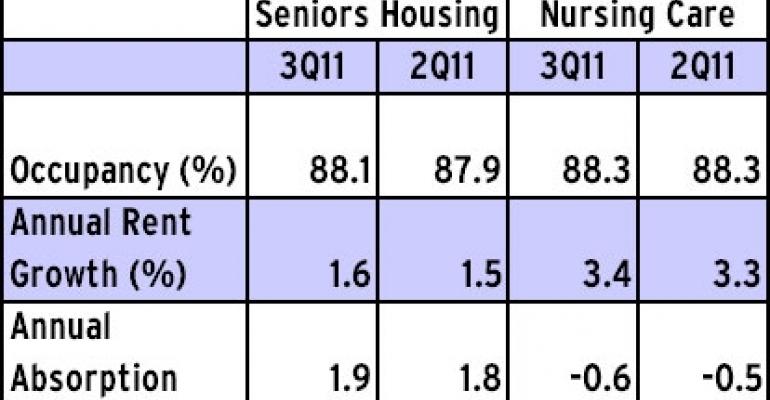The seniors housing market continued its recovery in the third quarter of 2011, even while overall construction activity continued to decline, according to NIC MAP, a data analysis service of the National Investment Center for the Seniors Housing & Care Industry (NIC), based in Annapolis, Md.
The overall average occupancy rate for seniors housing properties in the third quarter of 2011 was 88.1 percent, up 0.2 percentage points from the prior quarter. The seniors housing average occupancy rate has risen in six consecutive quarters and is currently 1.0 percentage points above its cyclical low of 87.1 percent in the first quarter of 2010.

The average occupancy rate for independent living properties in the third quarter of 2011 was 87.9 percent, and the average occupancy rate for assisted living properties was 88.6 percent, showing improvement from the second quarter occupancy rates of 87.5 percent and 88.5 percent, respectively. The average occupancy rates for independent living and assisted living have risen to 1.0 and 1.1 percentage points, respectively, above their cyclical lows.
“The third quarter data tells us that it is clear we have moved past the cyclical bottom which was established back in 2010,” says Michael Hargrave, NIC Map seniors housing vice president. “The occupancy rate was up modestly in this past quarter, around 20 basis points, but the quarter showed us that there were very high levels of absorption, some of the highest that we’ve seen over the past few years.”
Year-over-year rent growth for seniors housing increased to 1.6 percent, from 1.5 percent in the second quarter of 2011 and 1.2 percent in the third quarter of 2010. For seniors housing properties, annual absorption was 1.9 percent in the third quarter of 2011, compared to 1.8 percent in the second quarter and 1.7 percent a year ago.
In the third quarter, the seniors housing annual inventory growth rate was 1.0 percent, which is down from 1.1 percent in the second quarter of 2011 and 1.9 percent in the third quarter of 2010, which is the lowest level that has been seen in the current market cycle. The construction vs. inventory level for seniors housing was 1.5 percent, which is down from 1.8 percent in the previous quarter.
“Next quarter we’re expecting a higher level of inventory growth than this quarter,” says Hargrave. “That could push upward pressure on occupancy over the next year.”
The nursing care occupancy rate remains stable at 88.3 percent in the third quarter, unchanged from the previous quarter. This stability in occupancy has been reported since the second quarter of 2010 in this sector. Nursing care annual inventory growth was -0.3 percent in the third quarter of 2011, illustrating the established trend of slightly declining inventory growth. Private pay rents for the sector grew 3.4 percent year-over-year this quarter, which is a slight increase from the 3.3 percent pace reported in the second quarter of 2011.

